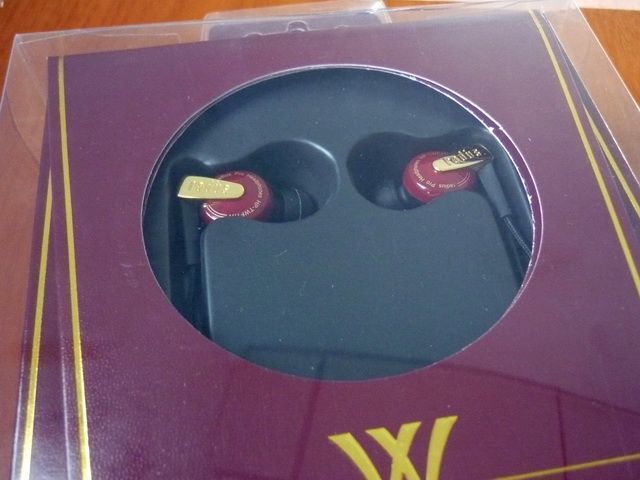
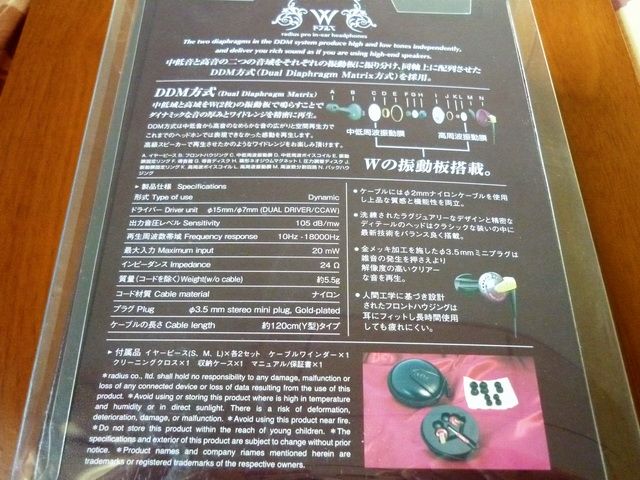
SPEC
Transducer: Dual dynamic 7mm / 15mm
Sensitivity: 105dB/mW
Freq. Resp.: 10Hz – 18kHz
Max Imput: 20mW
Impedance: 24ohm
Weight (w/o cable): 5.5g
Cable: 1.2m Nylon
Plug: 3.5mm Gold plated
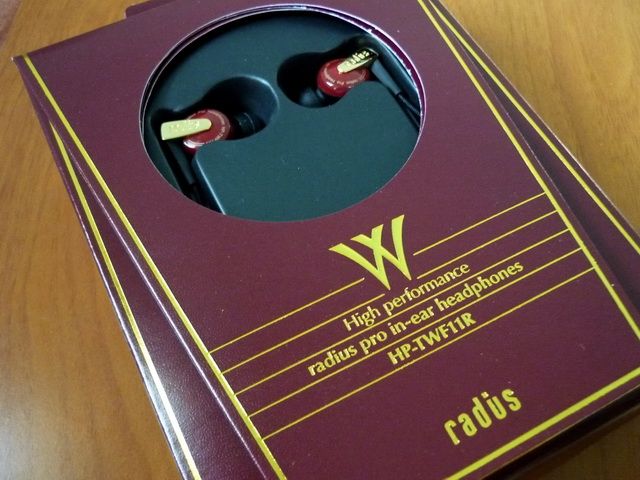
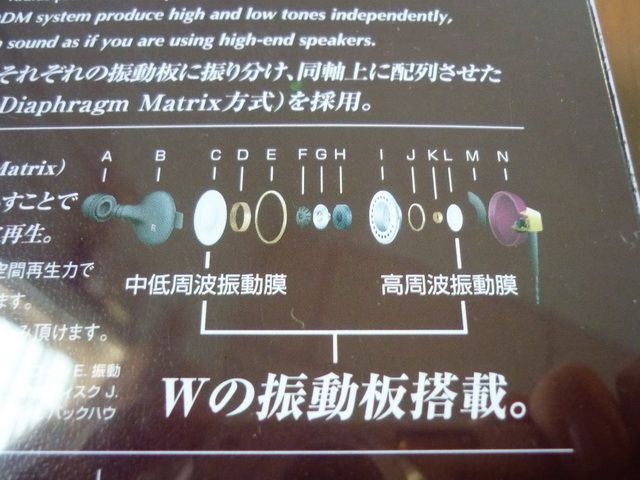
Tech Prelude
So what is the so called ‘Dual Diaphragm Matrix’? Typical dynamic driver has one diaphragm attached to an electric coil. The coil is usually placed around a rounded magnet. When the electric current (signal) passes through the coil, it forms an electro-magnetic field and is either repelled or attracted by the magnet’s own magnetic field. The movement of the coil (which is dictated by the ever changing signal) causes the diaphragm to vibrate at different rate, which in term causes the air to vibrate and produce sound wave. In a typical dual dynamic driver earphone, such as those earbuds invented by Panasonic quite some time ago, there are simply two dynamic drivers with independent diaphragm, coil and magnet. The signal is separated by a crossover and fed into the two drivers, one as tweeter unit while the other as mid/bass driver. The difference between a typical dual dynamic driver earphone and the DDM is that there is only one magnet in the DDM. The mid/bass driver’s larger coil goes around the outer rim of the magnet while the tweeter unit’s coil fits around the inner rim of the same magnet, with the two diaphragms each facing a different direction and occupied each side of the magnet. The result is a dual dynamic drivers’ setup that have the physical size of only one driver. With this new technology, the Radius HP-TWF11R is born.
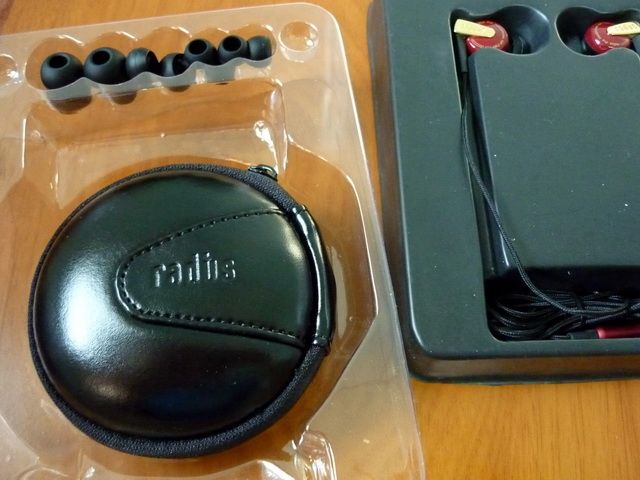
Packaging, Accessories and Build Quality
If anything else, I guess the packaging of DDM can be considered as fancy, to say the least. But it is not without its flaw. The dark red and gold scheme looks very classy, but I couldn’t understand why they choose an outer plastic case that is one size larger than the inner paper box, like it is a last minutes decision where things are put together in a rush.
I also have a mixed feeling about the included accessories. On one hand, the leather hard case is simply one of the best cases I ever see. The cord winder is a little too big and troublesome to be practical in daily use, but it does present as a good tool for more permanent storage. The microfiber cleaning cloth will keep the IEM shiny enough. On the other hand however, the eartips are pretty inadequate. They are scratchy and way too soft to work with the earpieces.
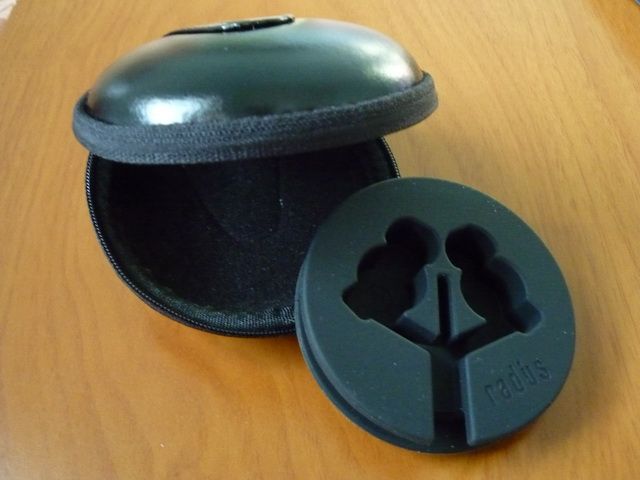

DDM’s transducer use a side-mounting design pioneered by Sony MDR-EX700. It is pretty much one of the most sensible way to put a large transducer close to the ear canal as much as possible. But the way (or more correctly, the angle) Radius uses the design in DDM makes the fit a hit or miss for many people, especially for those who have small outer ears. The cable has a fabric sleeve, which is both classy and bad for microphonics. The strain relief on the Y-splitter is a little inadequate, but otherwise decent elsewhere. The earpieces themselves are not particularly light, so is the fabric sleeved cable – coupled with the fact that the stock eartips does not offer a very secure seal, it almost feels like the whole IEM is being dragged around by its own weight and ready to fall out anytime. It is no doubt that the DDM designer is shooting for an elegant design that will make it stands out from the crowd (and it does!!!), but unfortunately it simply isn’t the most ergonomically feasible. However DDM is not a lost cause. What I will suggest to a DDM owner is either single or bi-flanges eartips from UE (*bi- is more secure and easier to fit) and a shirt clip. A good quality eartips will provide an easier fit while the shirt clip will reduce the problem on weight and microphonics. Once these issues have been taking care of, DDM will turn into a very enjoyable experience.
The one downside that can’t really be cured is the poor isolation, which is just slightly better than an earbud with a tight fit. So a warning to anyone who is considering the DDM as their next purchase: this is not an IEM that will give you a decent amount of isolation. Be prepare to use it in home most of the time, and I do mean a relatively quiet home.
Despite its flaws, DDM is still pretty good in use once you understand its weaknesses and are able to fix / live with them. What DDM can offer in return is a sound quality that is punching beyond its price category and makes it well worth the effort for the user.
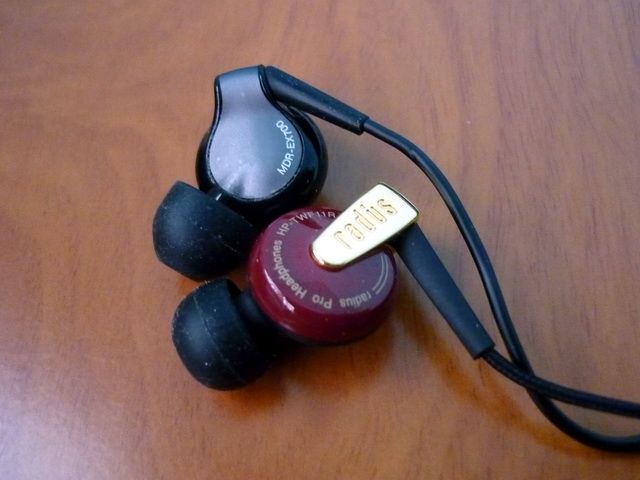
DDM next to Sony MDR-EX700
Sound Quality
As usual, a 50 hours burn-in is carried out before the review. I took a quick listening before the burn-in process and I was a bit worry about what I heard: The bass was great and I could hear a decent amount of treble detail, but something was missing – the mid. It seemed the two frequency ranges were separated too far apart and it made the whole presentation unnatural, like three way speaker with blew mid-range drivers. The good news is that after the burn-in, the sound becomes very much coherent to my ears, as if there is no such thing as dual drivers in the IEM (which is a good thing!). Whether you want to believe this is the result of burn-in or not, I guess there is no harm to do a burn-in before you give this IEM a serious audition, and certainly before you decide whether this IEM is for you or not.
There are a few other really good, top-tier IEM that share the same warm and sweet sound as DDM, like SE530 or e-Q7. What really separates DDM from the other is a bass that is both great in quantity and quality. One thing I love about DDM’s bass is how much texture it has. Personally speaking, I am nowhere near being a basshead and generally avoid too boomy a bass that often makes me feel like I am going to have motion sickness. However, DDM’s bass is something I can really enjoy, and even fall in love to. It is big, but not excessively boomy, so well textured that it makes the bass sound very realistic, as if I am almost listen to live performance. The problem with bass is on its speed and decay. Too fast and it sounds thin (as many BA based IEM tend to be), too slow and it got smeared all over the place and lost the resolution and texture (as many big boomy dynamic IEM are). With DDM, it is like it has the perfect balance of all the elements that makes for a great, highly enjoyable bass. It is not a bass that drills with precision or punches with brute force, but a true marriage of beauty and beast. That is the backbone of the DDM’s sound.
With such a great bass, what more can you ask for? Answer: a good mid. The surprising thing about the mid is the position: not in-your-face forward, but forward enough to show character. It gives enough detail and texture so not to get drowned by the bass. The mid+ bass combination gives a sound that is sweet, juicy and life-like. This makes DDM especially good for listening to vocal of the lower region.
Treble is what defines the limitation of DDM. It has a good extension and resolution, but too smooth and sparkle-less on the top to give any excitement, like taking a backseat in the overall sound. Without a good amount of crispiness to highlight the micro detail, female vocal, string and cymbal sound just a bit dull. It is definitely not good for a diva or violin performance.
Soundstage is fairly good. It could be better but crippled by a mediocre separation. Perhaps the mid- + bass combination that gives DDM the warm and lushness simply isn’t enough to place everything in the right position without a strong support from the treble.
So what is DDM’s sound signature? In short: Musical, warm and sweet with a great bass and a smooth top. Perfectly suited for laid back, casual listening session.
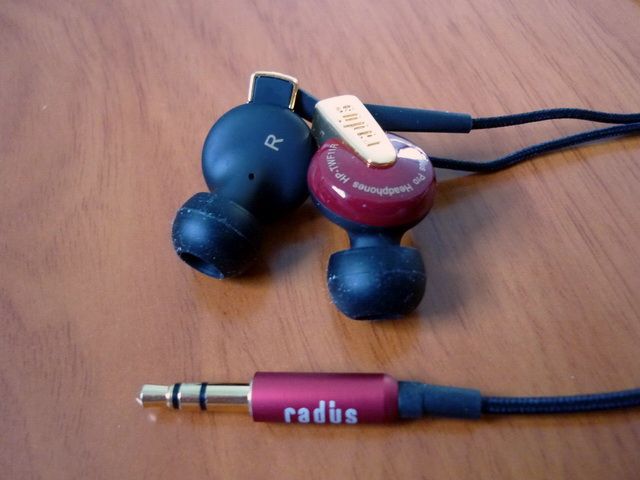
Verdict
DDM is not the be-all-end-all as far as IEM is concerned. Yes, it has its flaws, but as always it really depends on whether you can live with them or not. I mean, is there actually a flawless IEM to begin with? For the asking price of around US$160, DDM is a unique IEM that offers a unique sound that is beyond what the price tag has suggested. If sound quality is the only factor for consideration, it is well worth a try.
The second generation of DDM is said to be released in later this year. Hopefully Radius can further improve on the original design and give us a true top-tier this time. Fingers crossed.

This above rating is for Radius HP-TWF11R only and may change without notice. Please refer to the list for a complete listing.





